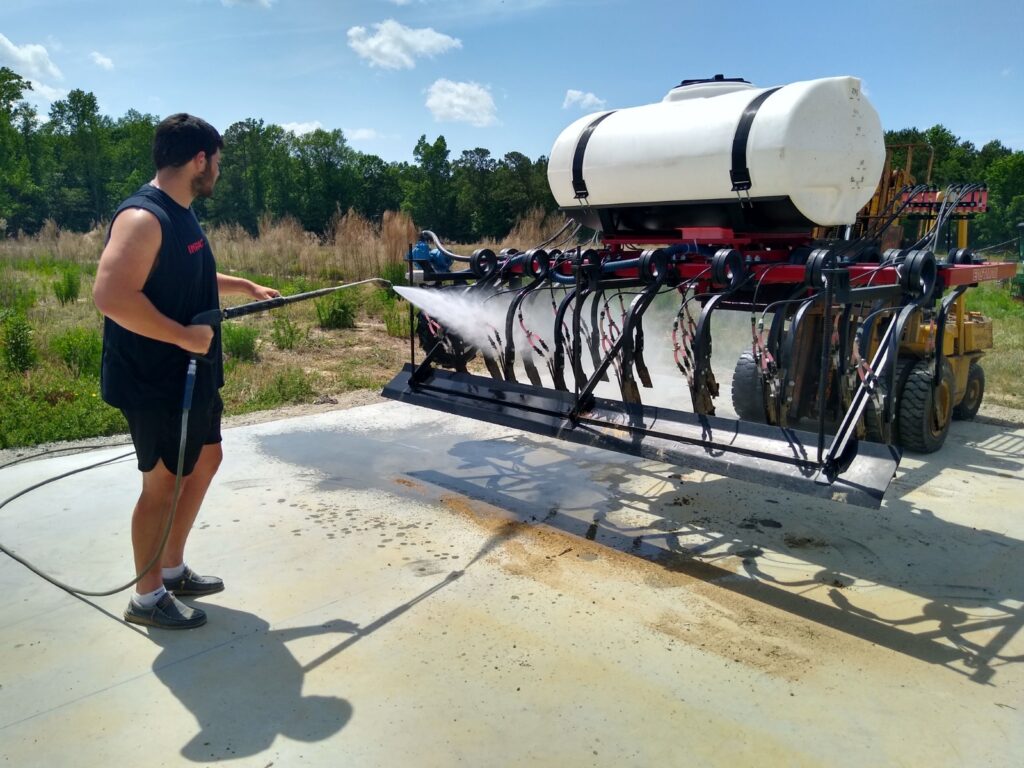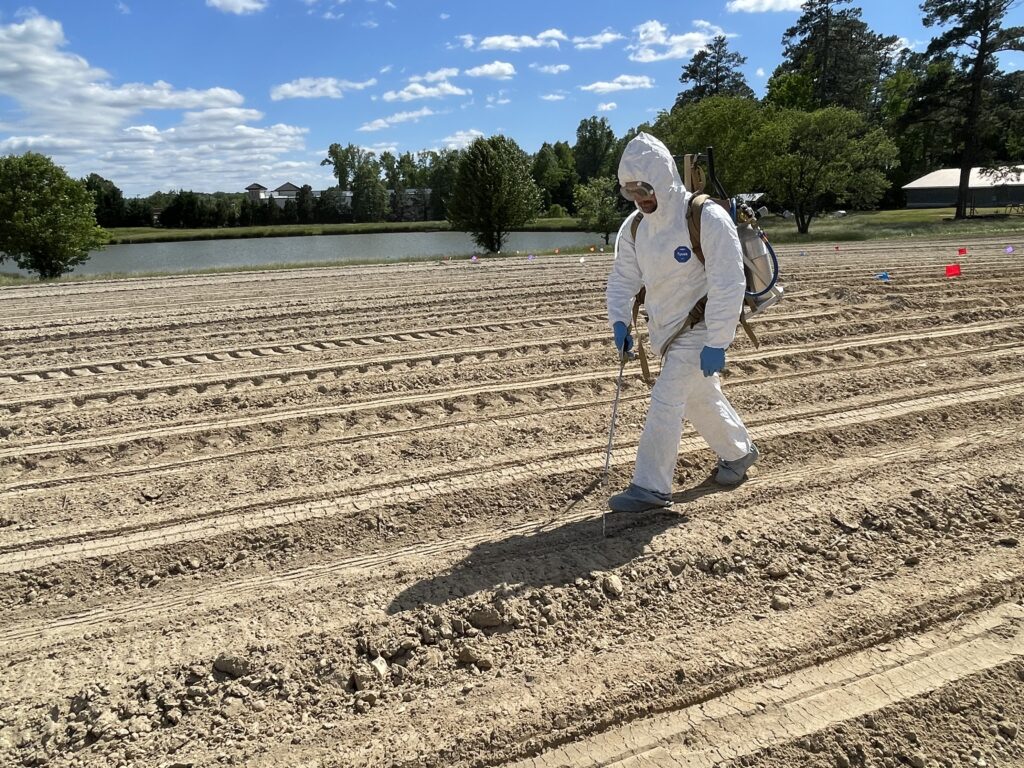Root-Knot Nematode Management
Managementment of root-knot nematodes in sweetpotato is accomplished by various strategies or management types.
Field Selection and Planting Material
The first management strategy addresses field selection and acquisition of planting material. Prior to planting sweetpotato slips or seed potatoes, the field of interest should be sampled for the presence of root-knot nematodes. Soil samples should be taken in accordance with the recommendations provided by a nematology diagnostic laboratory. Samples can be sent to the diagnostic laboratory for the purposes of quantifying root-knot nematodes in each field and providing the identity (species) of any root-knot nematodes found.
If root-knot nematodes are detected in the sampled field, it is best to take appropriate further steps for reducing the number of nematodes present in the field (See section below on Fumigants/Nematicides). Additionally, seed roots should not be planted in field sites that have root-knot nematodes present. When acquiring planting material, purchase certified seeds from certified clean seed distributors to prevent the introduction of root-knot nematodes into field sites and future production and seed potatoes. Further, when purchasing planting material such as slips, purchase from growers that follow protocols that minimize and prevent nematode movement or nematode introduction. Practices include minimizing the movement of soil within and between greenhouses, utilizing clean knives when cutting planting material, and making cuts above the soil line to prevent the wound from encountering soil-borne pathogens such as nematodes.
Prevent or Limit Movement
As previously stated, root-knot nematodes are soilborne pathogens that are transmitted primarily through the movement of infected soil, infected plant material, or water through irrigation or flooding events. With this in mind, ensure that infected plant material, including slips and seed potatoes, are not planted in fields. When working in fields that are known to be infested with root-knot nematodes, wear shoe covers and/or sanitize shoes and clothing that comes into contact with soil or plant material when finished working in the field. Additionally, any equipment that is utilized for work in an infested field must be sanitized after use. Last, ensure that irrigation water is not derived from a site that is infested with root-knot nematodes.

Credit: Adrienne Gorny
Cultivar Resistance
One of the most effective strategies for the management of root-knot nematodes is the use of sweetpotato cultivars that are resistant to root-knot nematodes. So, when plausible, it is encouraged to plant cultivars that are designated as resistant. When looking to identify a cultivar of interest for planting, look to see if the cultivar is designated as resistant to specific species such as M. enterolobii or M. incognita. There are cultivars that may be designated as resistant to M. incognita but may be susceptible to M. enterolobii, meaning you would not want to plant this cultivar if you have an M. enterolobii infestation. Below is a table that illustrates the resistance or susceptibility of different sweetpotato cultivars to both Meloidogyne incognita and Meloidogyne enterolobii.
Table 1. The below table has been adapted from the NC State Extension Crop Production Management Chapter on Sweetpotatoes, the LSU AgCenter Sweet Potato Variety Descriptions Factsheet, and “Screening Sweetpotato Genotypes for Resistance to a North Carolina Isolate of Meloidogyne enterolobii” by Schwarz et al., 2021.
Table Scale: R = Resistant, S = Susceptible, I = Intermediate, HR = Highly Resistant, MR = Moderately Resistant, MS = Moderately Susceptible, – = Unknown.
| Sweet Potato Cultivar | Meloidogyne incognita (Southern Root-Knot Nematode) | Meloidogyne enterolobii (Guava Root-Knot Nematode) |
|---|---|---|
| Averre (NC05-198) | S | S |
| Bayou Belle | I-R | S |
| Beauregard | S | S |
| Bellevue | HR | S |
| Bonita | R | S |
| Burgundy | R | S |
| Centennial | S | R |
| Covington | R | S |
| Diane | - | |
| Evangeline | HR | I-S |
| Hernandez | R-I | S |
| Jewel | I-R | R |
| Mahon | S | |
| Murasaki-29 | HR | R |
| NC04-531 | R | S |
| O’Henry | S | |
| Orleans | S | S |
| Porto Rico | I-S | - |
| White Bonita | - |
Nematode Control
Fumigants/Nematicides
Fumigant or nematicide application is often recommended when there are large populations of root-knot nematodes detected in a field of interest via soil samples. Oftentimes, it is recommended that high application rates are utilized for fields where M. enterolobii is identified or if the root-knot nematode population warrants the use of this high rate.

Credit: Sam Mowery
Learn more about fumigant and nematicide application protocols for sweetpotato in each state associated with the SweetARMOR project.
Weed Management
Weed management can be utilized as an effective strategy to reduce root-knot nematode populations within the soil. Sometimes called a “green bridge”, weeds can serve as additional hosts for root-knot nematodes. Not only can weeds serve as an additional host within the growing season, particularly if there are substantial weed populations within fields, but weeds can also serve as overwintering hosts. Essentially, root-knot nematode populations decline when there is an absence of a suitable host and in this case, this coincides with the absence of sweetpotatoes in the winter months. However, when there are weeds that can serve as hosts for the root-knot nematodes and sustain the present root-knot nematode population, the population will either remain the same or increase. Knowing the role which these weeds can play is critical to the reduction of root-knot nematode populations, so, when possible, it is good to implement weed management practices both in season and out of season.
Learn more about weed management strategies specific to sweetpotato production.
Crop Rotations
Crop rotation can also serve to reduce the levels of root-knot nematodes in the soil. Crop rotations include planting a nonhost crop or less susceptible crop the season prior to and the season following a host crop, in this case, sweetpotato. The presence of a nonhost or less susceptible crop will prevent the root-knot nematodes from reproducing and prevent their ability to either sustain or increase their population. For organic production systems, crop rotation can play an integral role in nematode population management and suppression. For M. enterolobii and M. incognita, maize or peanuts are considered less susceptible hosts that can be incorporated into crop rotations to reduce their populations (Quesada-Ocampo, 2021).